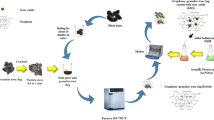Abstract
A technique of synthesis of new sorption materials by hydrothermal carbonization of sunflower meal (HTS) with the addition of graphene oxide (GO) and subsequent carbonization (C) has been developed. To assess morphological and phase changes during carbonization, the materials have been characterized by scanning electron microscopy and IR spectroscopy. According to the results obtained, carbonization facilitates the development of latent porosity and reduces the amount of oxygen-containing and alkyl groups. Kinetic sorption studies have also been carried out by the example of extraction of Pb2+ ions and organic dye molecules (methylene blue (MB)). The experimental results show that the adsorption capacities of the HTS, HTS/C, HTS/GO, and HTS/GO/C composites were 82.9, 108.6, 168.9, and 148.3 mg/g, respectively, for extraction of Pb2+ ions and 1481.8, 1601.1, 1920.3, and 2283 mg/g, respectively, for extraction of MB molecules. It is established that, during the absorption of MB molecules, carbonization affects significantly the contact time. Carbonized samples exhibit high sorption activity, which results in the equilibrium contact time of 15 min (this value is 60 min for noncarbonized samples). The equilibrium time during the adsorption of Pb2+ ions is 60 min for all samples. The adsorption kinetics is described using the following models: the pseudo-first-order model, pseudo-second-order model, Elovich model, and intraparticle diffusion model. It is found that the adsorption process is limited by the chemical-exchange reaction and runs in a mixed-diffusion mode.





Similar content being viewed by others
REFERENCES
E. S. Mkrtchyan, O. A. Anan’eva, I. V. Burakova, A. E. Burakov, and A. G. Tkachev, Adv. Mater. Technol. 7, 228 (2022). https://doi.org/10.17277/jamt.2022.03.pp.228-237
E. S. Mkrtchyan, I. V. Burakova, A. E. Burakov, O. A. Anan’eva, T. P. D’yachkova, and A. G. Tkachev, Zhidk. Krist. Prakt. Ispol’z. 22 (3), 38 (2022). https://doi.org/10.18083/LCAppl.2022.3.38
H. Khurshid, M. R. U. Mustafa, and M. H. Isa, Environ. Res. 212, 113138 (2022). https://doi.org/10.1016/j.envres.2022.113138
M. Liu, E. Almatrafi, Y. Zhang, P. Xu, B. Song, C. Zhou, G. Zeng, and Y. Zhu, Sci. Total Environ. 806, 150531 (2022). https://doi.org/10.1016/j.scitotenv.2021.150531
P. S. Kumar, R. Gayathri, and B. S. Rathi, Chemosphere 285, 131438 (2021). https://doi.org/10.1016/j.chemosphere.2021.131438
T. A. Khan, A. S. Saud, S. S. Jamari, M. H. A. Rahim, J. W. Park, and H.-J. Kim, Biomass Bioenergy 130, 105384 (2019). https://doi.org/10.1016/j.biombioe.2019.105384
Y. X. Seow, Y. H. Tan, N. M. Mubarak, J. Kansedo, M. Khalid, M. L. Ibrahim, and M. Ghasemi, Environ. Chem. Eng. 10, 107017 (2022). https://doi.org/10.1016/j.jece.2021.107017
S. Yadav, A. Yadav, N. Bagotia, A. K. Sharma, and S. Kumar, Water Process Eng. 42, 102148 (2021). https://doi.org/10.1016/j.jwpe.2021.102148
A. Ronix, O. Pezoti, L. S. Souza, I. P. A. F. Souza, K. C. Bedin, P. S. C. Souza, T. L. Silva, S. A. R. Melo, A. L. Cazetta, and V. C. Almeida, Environ. Chem. Eng. 5, 4841 (2017). https://doi.org/10.1016/j.jece.2017.08.035
Z. Zhou, Z. Xu, Q. Feng, D. Yao, J. Yu, D. Wang, S. Lv, Y. Liu, N. Zhou, and M. Zhong, Cleaner Prod. 187, 996 (2018). https://doi.org/10.1016/j.jclepro.2018.03.268
R. Negi, G. Satpathy, Y. K. Tyagi, and R. K. Gupta, Int. J. Environ. Pollut. 49, 179 (2012). https://doi.org/10.1504/IJEP.2012.050898
M. Alam, R. Nadeem, and M. I. Jilani, Int. J. Chem. Biochem. Sci. 1, 24 (2012).
A. Elham, T. Hossein, and H. Mahnoosh, Appl. Sci. Environ. Manage. 14 (4) (2011). https://doi.org/10.4314/jasem.v14i4.63306
S. Pap, V. Bezanovic, J. Radonic, A. Babic, S. Saric, D. Adamovic, and S. M. Turk, J. Mol. Liq. 268, 315 (2018). https://doi.org/10.1016/j.molliq.2018.07.072
X. Ma, Y. Liu, Q. Zhang, S. Sun, X. Zhou, and Y. Xu, Cleaner Prod. 331, 129878 (2022). https://doi.org/10.1016/j.jclepro.2021.129878
T. S. Hubetska, N. G. Kobylinska, and J. R. García, Anal. Appl. Pyrolys. 157, 105237 (2021). https://doi.org/10.1016/j.jaap.2021.105237
D. Uygunoz, F. Demir, M. Y. Ozen, and E. M. Derun, Chem. Data Collect. 40, 100893 (2022). https://doi.org/10.1016/j.cdc.2022.100893
I. Anastopoulos, J. O. Ighalo, C. Adaobi Igwegbe, D. A. Giannakoudakis, K. S. Triantafyllidis, I. Pashalidis, and D. Kalderis, J. Mol. Liq. 342, 117540 (2021). https://doi.org/10.1016/j.molliq.2021.117540
M. E. Saleh, A. A. El-Refaey, and A. H. Mahmoud, Soil Water Res. 11, 53 (2016). https://doi.org/10.17221/274/2014-SWR
S. Román, J. M. V. Nabais, C. Laginhas, B. Ledesma, and J. F. González, Fuel Process. Tech. 103, 78 (2012). https://doi.org/10.1016/j.fuproc.2011.11.009
I. Pavkov, M. Radojčin, Z. Stamenković, S. Bikić, M. Tomić, M. Bukurov, and B. Despotović, Solid Fuel Chem. 56, 225 (2022). https://doi.org/10.3103/S0361521922030077
S. K. Lagergren, Sven. Vetenskapsakad. Handingarl. 24, 1 (1898).
Y. S. Ho and G. McKay, Water Res. 33, 578 (1999). https://doi.org/10.1016/S0043-1354(98)00207-3
I. S. Mclintock, Nature (London, U.K.) 216 (5121), 1204 (1967). https://doi.org/10.1038/2161204a0
W. Weber and J. Morris, J. Sanit. Eng. Div. Am. Soc. Civil Eng. 89, 53 (1963).
ACKNOWLEDGMENTS
This study was performed using facilities of the Center for Collective Use “Production and Application of Multifunctional Nanomaterials” of Tambov State Technical University.
Funding
This study was supported by the Russian Science Foundation, grant no. 22-13-20074, https://rscf.ru/project/22-13-20074.
Author information
Authors and Affiliations
Contributions
A.E. Burakov: methodology of the study, editing the text of the article.
T.S. Kuznetsova: conducting experimental studies on the synthesis of hydrothermal carbon.
I.V. Burakova: development of the scientific work concept, writing the text of the article, preparation of illustrations.
O.A. Ananyeva: conducting adsorption experimental studies.
E.S. Mkrtchyan: conducting adsorption experimental studies.
T.P. Dyachkova: characterization of the nanocomposite and describing the results obtained.
A.G. Tkachev: consultation on planning, editing the text of the article.
Corresponding author
Ethics declarations
The authors of this work declare that they have no conflict of interest.
Additional information
Translated by A. Sin’kov
Publisher’s Note.
Pleiades Publishing remains neutral with regard to jurisdictional claims in published maps and institutional affiliations.
Rights and permissions
About this article
Cite this article
Burakov, A.E., Kuznetsova, T.S., Burakova, I.V. et al. Hydrothermal Synthesis of High-Efficiency Carbon Sorbent Based on Renewable Resources. Tech. Phys. Lett. 49, 151–158 (2023). https://doi.org/10.1134/S106378502370013X
Received:
Revised:
Accepted:
Published:
Issue Date:
DOI: https://doi.org/10.1134/S106378502370013X




